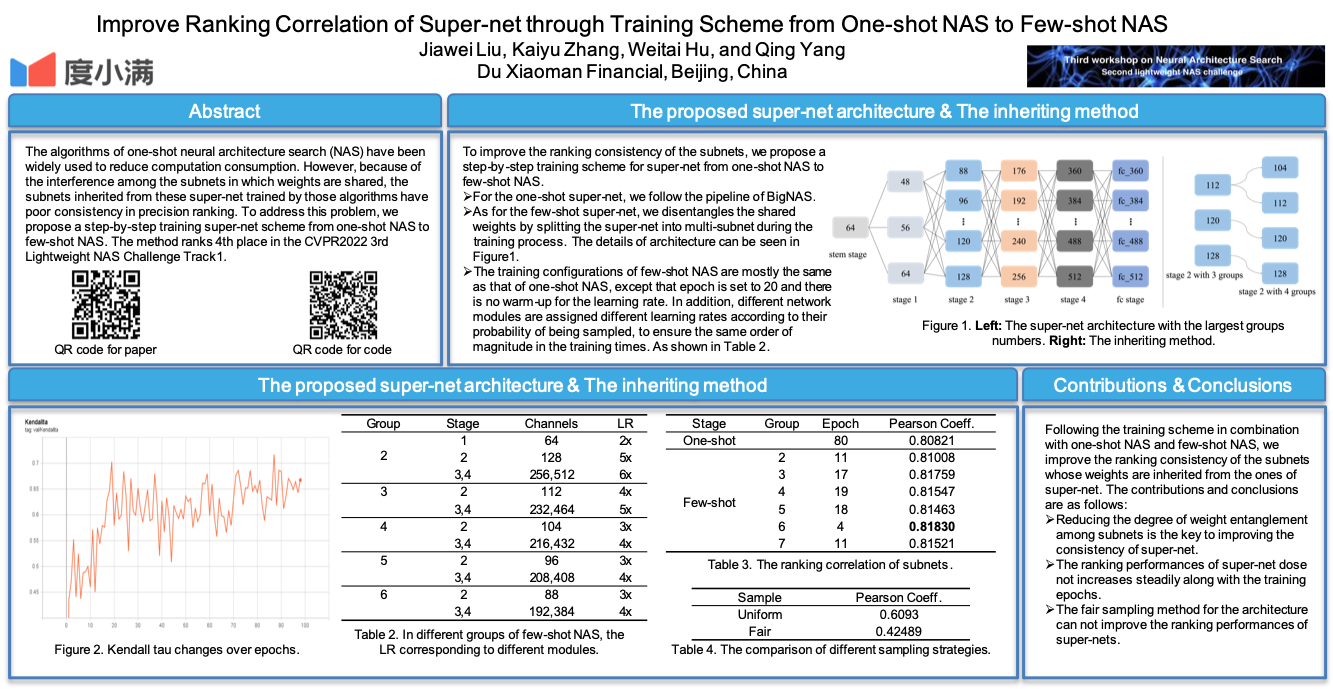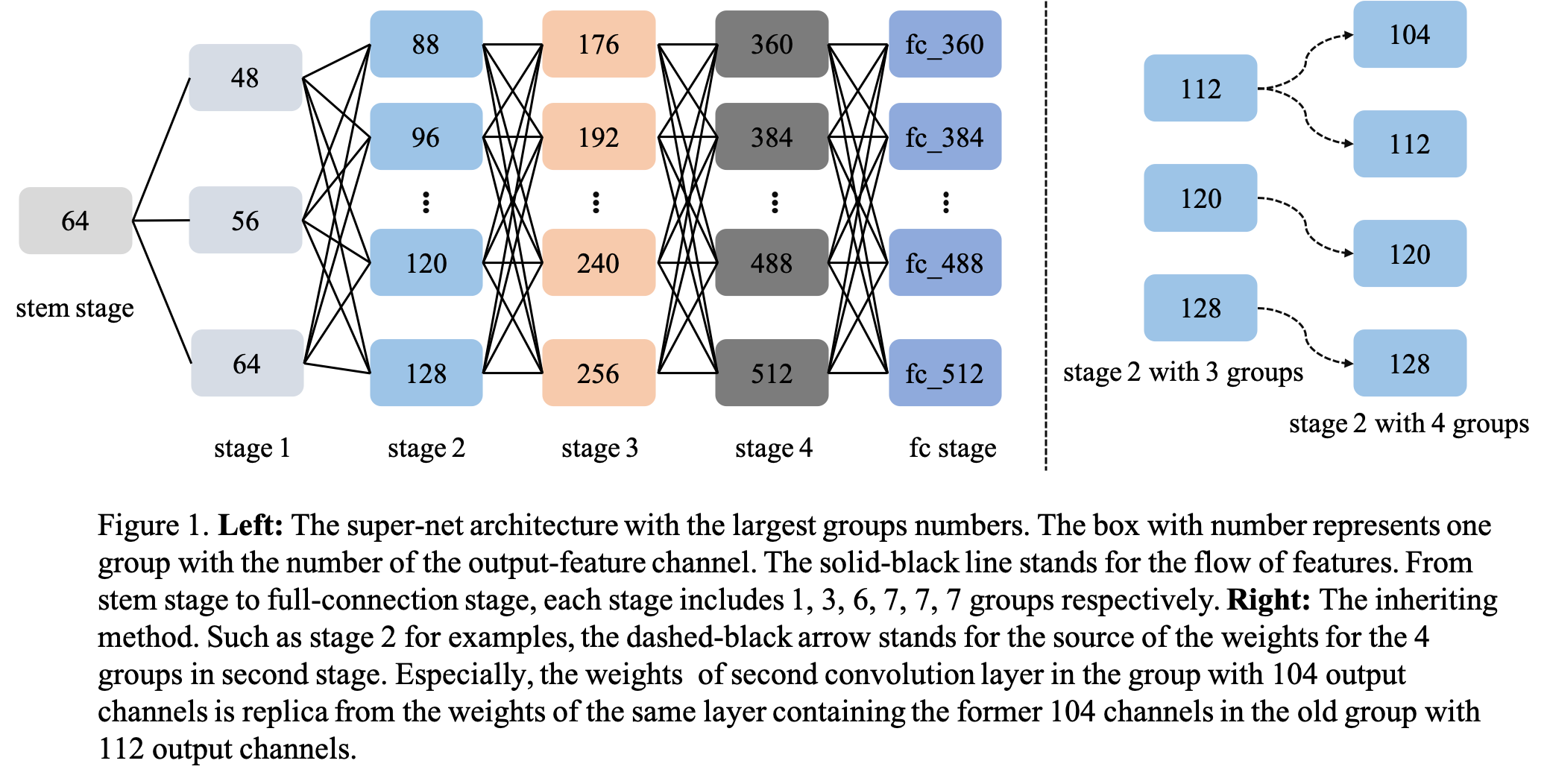The official website of the competition:CVPR2022 NAS track1
Brought to you by We NAS from Kaiyu Zhang,Jiawei Liu,Weitai Hu from Du Xiaoman Financial.
Team Member: Weitai Hu (胡伟泰) (Leader), Kaiyu Zhang (张凯昱), Jiawei Liu (刘嘉炜)
maintainer:liujiawei2333,nick
paper:Improve Ranking Correlation of Super-net through Training Scheme from One-shot NAS to Few-shot NAS
Video:Improve Ranking Correlation of Super-net through Training Scheme from One-shot NAS to Few-shot NAS
Please follow readme.ipynb to reproduce the results.
Note: All Python files must be run under DistributedDataParallel.
- Model Construction and Optimization
- Train standalone
- Train one-shot supernet
- Train few-shot supernet
- Evaluate
To improve the ability of supernet in evaluating the performance of subnets, we construct two models for training, following the one-shot way and few shot way respectively.
- model construction
For the one-shot model, we build the architecture of supernet according to the BigNAS. For the few shot model, we extend the number of group for every stage in supernet (each stage in one-shot model only have one group). For each group in the same stage of few shot model, there are different channel numbers in the second convolution layer in the resnet-block. The left of the Figure 1 shows the architecture of the few shot supernet. - model optimization
We follow the training strategy of BigNAS for the one-shot supernet. For the training of few shot supernet, we extend the number of group for every stage from 2 to the maximum (the maximum is the number of channel candidate in every stage). For the supernet with the larger group, its weights inherit from the ones of the supernet with the smaller group. Following the training strategy of BigNAS again, we train the few shot model sequentially along with the increase of the number of group. The right of the figure 1 shows the inheriting method.
Before training supernet, we need to prepare dataset under ./data folder. Please first download the ImageNet dataset and move it to ./data/. There includes three textual document under ./data, named train.txt, valid.txt and valid_part2500.txt, which contain the restive path of images and the corresponding labels. The third textual document is used as the valid datasets to get the accuracy of 30 subnets. Before use the aforementioned textual documents, please change the restive image paths to the absolute ones according to your local environment.
Then, we need to import the necessary modules.
This part is not required, and its purpose is to generate the accuracy of 30 subnets trained standalone. If you don't want to repeat this step, use ./json_file/gt_arch30.json directly.
In the subsequent training supernet, we will evaluate the accuracy of these 30 subnets and calculate kendall tau with ./json_file/ gt_arch30. json in the evaluation stage after each epoch, as a reference to select the best supernet model in this stage. Although this coefficient will not match the score coefficient on the competition website, it can serve as a rough screening model.
The basis of model selection: the model with the later epoch and the largest Kendall tau.
Note: Due to cost constraints, we only used 2500 test data to standalone train 30 subnets. As a comparison, there are 45,000 subnet pools to be evaluated on the competition website and 50000 test data, which leads to certain differences in Kendall tau.
PS:The value of target_arch_num is an integer ranging from 1 to 30.
python train_stand_alone.py --target_arch_num=1We first train one-shot supernet, and we need to change several parameters in ./configs/common.yml and ./configs/train_supernet_models.yml:
./configs/common.yml:
save: Directory to save files (models, logs, etc.)
./configs/train_supernet_models.yml:
warmup_epochs: 5
epochs: 100
python train_supernet.pyTraining few-shot spernet is divided into 6 stages, which are controlled by group_nums(2,3,4,5,6), and we need to change several parameters in ./configs/train_supernet_models.yml:
warmup_epochs:0
epochs:20
pretrained_path: The best supernet model selected from train one-shot supernet part.
python train_few_shot.py --group_nums=2 --pretrained_path='./results/save/supernet.pth'resumed_split_group:supernet inherited from group_num=resumed_split_group.
pretrained_path:The best supernet model selected from train few-shot supernet part when group_num=resumed_split_group.
python train_few_shot.py ---group_nums=3 --resumed_split_groups=2 --split_model_path='./results/save/2/supernet.pth'When group_nums is greater than 3, the meanings of parameters to be set are similar to those when group_nums is 3.
python train_few_shot.py ---group_nums=4 --resumed_split_groups=3 --split_model_path='./results/save/3_from_2/supernet.pth'python train_few_shot.py ---group_nums=6 --resumed_split_groups=5 --split_model_path='./results/save/5_from_4/supernet.pth'python train_few_shot.py ---group_nums=7 --resumed_split_groups=6 --split_model_path='./results/save/6_from_5/supernet.pth'Testing 45,000 subnets is time consuming, so we split all subnets into eight equal portions, see ./json_file/json8/, and then tested them in eight rounds.
We need to change several parameters in test.py.
json_part: 1,2,3,4,5,6,7,8,represent eight shared subnet files.
model_name: Name of the supernet to be evaluated.
epoch: Which epoch the supernet to be evaluated is stored in.
save: Target fold.
test_set: If taest_set=1, all the 50000 test sets in table are used; if test_set=0, only a small part of test sets are used (test_set=0 in the early stage to speed up the evaluation part, and 'test_set=1' in the later stage).
split_group: At which group_nums the supernet to be evaluated is trained and saved.
python test.py --json_part=1 --model_name='0.81_17' --epoch=17 --save='./save' --test_set=1 --split_group=2After the 8 evaluate steps are complete, we merge the 8 generated json files.
We need to change several parameters in merge.py.
save: target fold.
epoch: Which epoch the supernet to be evaluated is stored in. If you use all test sets, add _all_test suffix.
stage: '2' or '3_from_2' or '4_from_3' or '5_from_4' or '6_from_5' or '7_from_6'.
top:1 or 5,the default is 1.
python merge.py --save='./save' --epoch='17_all_test' --stage='3_from_2' --top=1'''Final evaluate file'''
final_file = './results/'+str(save)+'/'+str(stage)+'/json_results/'+'epoch/'+str(epoch_all_test)+'/top1_json_final.json'Our highest-scoring prediction files are located in ./results/save/6_fom_5/json_results/epoch/4_all_test/top1_json_final.json, corresponding to 0.8183 on Leaderboard A and 0.80599 on Leaderboard B.
Corresponding to the download address of the supernet file:
url: supernet file
Extract the code: bir0
Please place the model files under directory ./results/save/6_fom_5/.

